May 21, 2016

We get questions on colors all the time. What colors will one get if they add such and such an ingredient into their soap? What kind of hues will one get when using herbs and clays?
Here are a few quick tips for the curious and adventurous beginner ...
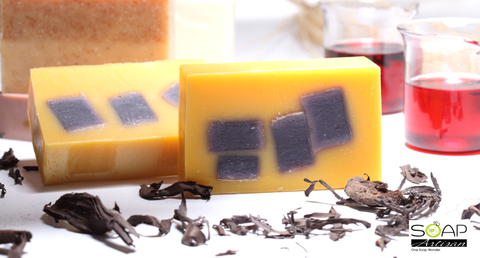
Try red palm oil for a pumpkin-hue soap. Depending on how much you use, red palm oil can result in soap bars with hues between yellow to orange. Did you know that red palm oil is rich in beta carotenes? That's where it gets its color from.
To get a rich yellow like the soap above, try using >30% red palm oil in your soap. You may need to decrease the percentage of coconut oil so that you can use more red palm oil in the formulation. Please note that sometimes the red palm oil can leave a light stain on your silicone soap molds. Also over time, we have found that the bright yellow or orange in the soap can fade to an almost white hue. Quick tip: Angel finds that adding in goat milk to the formula helps to maintain the yellow hue for a longer time.
At this point, we should add that it is not unusual for soap colors do undergo discoloration over time, especially if they are using 100% natural ingredients. You may notice your olive oil soaps turning from greenish white to a light brown over a span of a year. It is perfectly normal.
Let's move on to gromwell ...
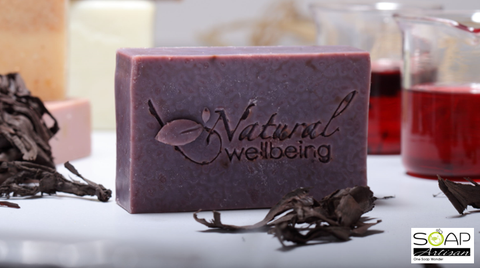
In traditional Chinese medicine, gromwell is taken internally to cool blood and invigorate the blood circulation system. Externally, it is said to help to reduce itching and relieve eczema. For soapmaking, the gromwell root or gromwell root powder can be infused in oil to get a purple hue in soaps. The soap above was made from an infusion of gromwell root soaked in olive and wheatgerm oil.
The depth of color may differ based on formulation, the amount of dried herb used during infusion as well as the curing time. The soap below also contains gromwell infused oil but its purple is more faded due to a longer curing period.

Next, indigo powder or 青黛粉...

Indigo powder has such a lovely blue but alas, the outcome after saponification is usually greyish-blue. Sometimes a bluish soap may be produced at the beginning, only to turn into greyish-blue over time. In the example below, the top layer of the soaps contain indigo powder.
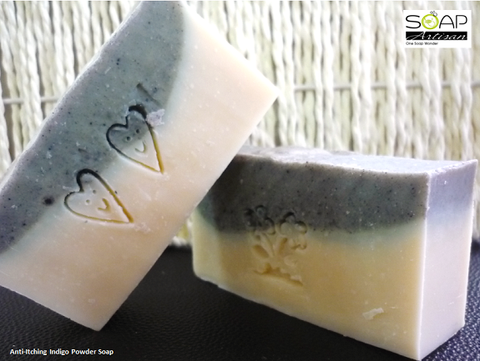
And then we have clays...
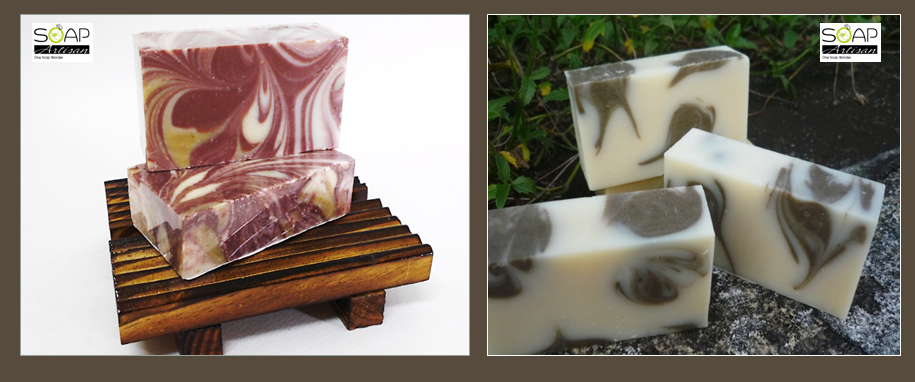
Red clay tends to impart a brownish-red hue to soaps and can be used to create soap swirls. However, it is not recommended to use too much (try to stick to below 2%) as red clay used tends to stain skin and clothes. If you are concerned with the skin-staining properties of red clay, try using pink clay. The example above left is a red clay soap with tinges of rosemary powder.
Besides red and pink clays, we have not found other organic clays to produce interesting colors. Do expect organic clays to yield soap colors in shades of browns or greys. In the above right picture, the soap swirls were made using Australian organic green clay. The green is olive gray and although it is a little dull , the swirl is nicely contrasted with the white background of the soap.
Black is always in, and so is charcoal!

Charcoal powder is often a favourite as it provides a fantastic contrast of black on a white soap. No charcoal powder? Try using organic black clay instead (but do note that black clay, like red clay, can stain skin and clothes).
Lastly, a word about dried flowers and herb powders.
Flower buds are pretty, but they don't maintain their colour when mixed into the soap. They turn brown over time due to the reaction between the herbs and the alkali in the soap. For example, the brown spots seen on the soap below are lavender buds which were infused in olive oil.
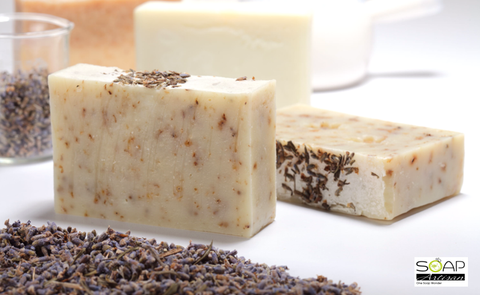
Same goes with other powders like green tea, rose bud, roselle, and osmanthus. The the example below shows osmanthus powder (deep yellow) side by side with an osmanthus soap. The osmanthus powder is located at the dark brown layer of the soap in the second picture. So, keep in mind that these herbal powders are added in soaps for their herbal properties to benefit the skin and less so for their color.

Having said all of the above, if you should encounter an experience where no one, not even Google, is able to tell you whether the powder will discolor during soap making, there may be no other way but to give it a try. It's part of the fun anyway and there is no end to experimenting new ingredients, ratios and formulas in soap making :)
That's all for now, folks. What's your experience with herbs and clays like? Do let us know!
Comments will be approved before showing up.
January 25, 2019
Sometimes, essential oils take most of the limelight overshadowing an equally important counterpart in any blend, which is the carrier oils. Carrier oils may be called as such because they "carry" the essential oils but they do have therapeutic properties to offer.
To know more about what oils work best for your therapeutic blend, read on.